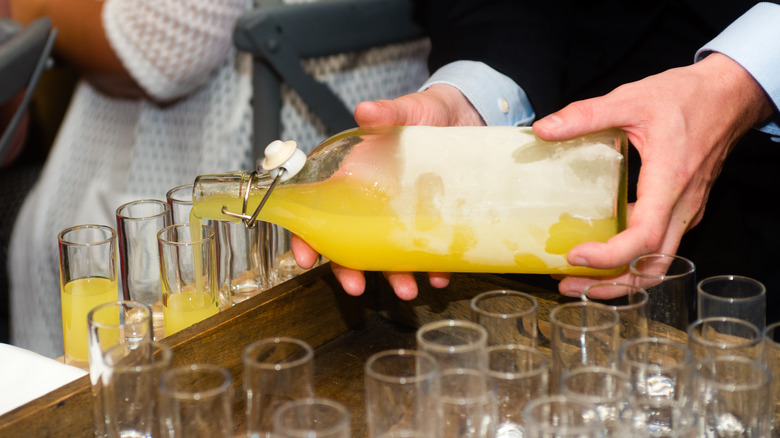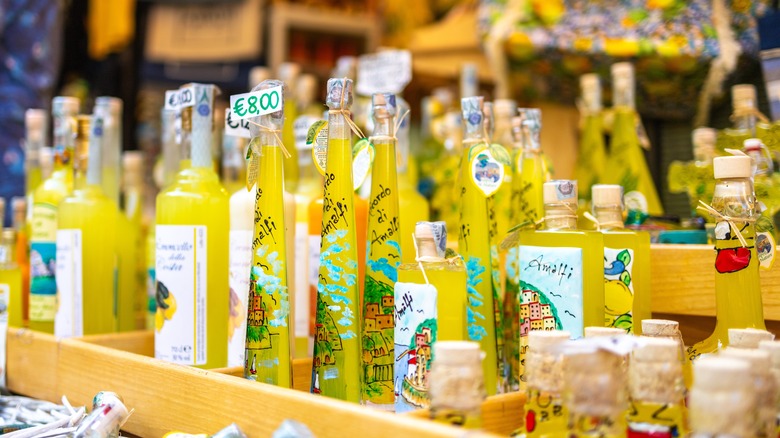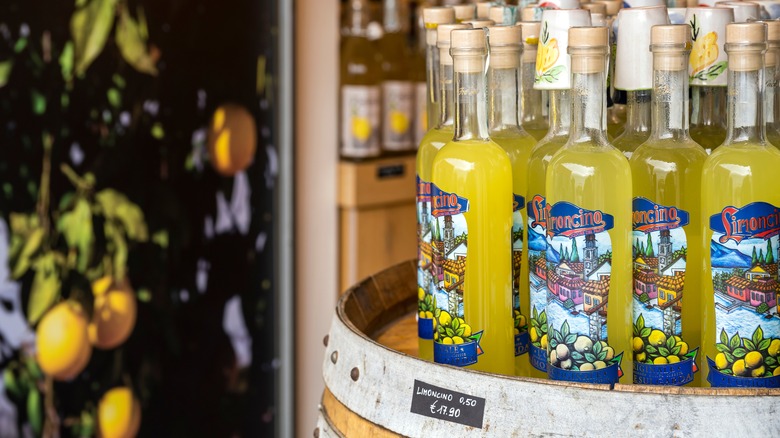Avoid Shooting This Iconic Drink While In Italy Even Though It's Served In A Shot Glass
Italy is a land that embraces the respectful and ceremonial enjoyment of alcohol. From north to south, the countryside is dotted with vineyards responsible for vino like the classy Chianti and the effervescent Franciacorta — and having a glass (or two) with a meal is a time-honored ritual since the days of Ancient Rome. Beyond wine, Italy is known for its wide variety of aperitifs, digestives, and liqueurs. Few drinks are as synonymous with a trip to Italy as the sun-kissed limoncello, but despite its presentation in a shot glass, this drink is meant to be savored, not downed. Here's why you should resist the urge to down limoncello in one big gulp and how to properly appreciate this beloved Italian beverage.
Limoncello traces its roots to the sun-kissed Amalfi Coast in the central-southern Campania region, particularly towns like Sorrento, Amalfi, and the island of Capri. The liqueur is crafted from the zest of locally grown lemons, specifically the Sorrento lemon, also known as Femminello Santa Teresa. These lemons are macerated in 90%-proof alcohol for a period of a few days to a few weeks until the citrus oils are released and the concoction takes on a distinct color. Then, the concentrate is mixed with simple syrup. The result? A vibrant, potent lemon liqueur with 25% to 30% alcohol content that tastes just like an Italian summer and embodies the essence of the region's citrus groves. It's also one of the best souvenirs you can get while in Italy.
Limoncello: an Italian classic
When life gave Italians lemons, they made limoncello. Other versions of limoncello exist, such as crema di limoncello, a milk-based version that contains less alcohol (about 15% to 20%). However, at what point they got those lemons and decided to make limoncello or its derivatives — no one knows for sure. Some say it was invented in a monastic convent, while others believe fishermen from the old empires used it to stay warm in the winter. Then, there is the story of 20th-century guesthouse owner Maria Antonia Farace, who supposedly created the recipe, with limoncello later patented in 1988 by Massimo Canale. The muddy origin story is a matter of debate.
One thing is certain: today, in Italy, limoncello is traditionally served chilled in a small glass after meals as a digestif, and it is to be sipped slowly and tastefully. It is a "local" drink that often rounds off a meal at many restaurants and homes nationwide — Rick Steves recommends ordering it as a cheaper alcohol option. Nearly always, it is served in a shot glass, but can also be prepared as a spritz, martini, or other type of cocktail. Limoncello can be considered a "guilt-free" drink — it aids in digestion after a meal, is packed with vitamin C and anti-inflammatory properties, and the lemons used to make it also contain antioxidants, limonene (cancer-fighting compound), folate, potassium, magnesium, phosphorus, and calcium. No wonder lemons are so revered and prolific in Italian culture.
The right way to enjoy limoncello
To fully appreciate limoncello, it should be served and enjoyed correctly. First, the limoncello should be authentic and traditionally made. If it has a PDO (Protected Designation of Origin), it indicates the liqueur was produced using organic lemons from either the Amalfi Coast or Sorrento — the ultimate marker of quality. Other countries also produce limoncello, but if you want the real deal, it has to come from its birthplace; this loyalty to regional diversity and quality is central to Italian food and drink. If you are ordering limoncello in a restaurant or bar, inquire with your server. The liqueur must be served ice-cold and always stored in the freezer. The thick, syrupy texture that results from freezing enhances the drinking experience (thank us later!).
Drinking it from the right glassware is also important. It is often served in small shot glasses. A cordial or small tulip-shaped glass also works, as it helps to concentrate the aromas, and the liqueur on its own is usually served two ounces at a time. Limoncello spritz or cocktails can be presented in tall glasses. If you are drinking the pure liqueur, take small sips. Allow it to linger on your palate. Pay attention to the layers of flavor and the aromatic qualities of the lemon oils. As the Italians say, "piano, piano" or "slowly, slowly" — no rush. Limoncello is best enjoyed with loved ones: friends, family, travel partners. Engage in conversation and make the moment a shared experience.


